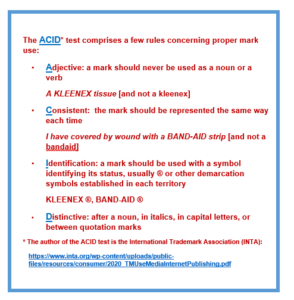
02 Feb When a trademark is genericised

– Get me a kleenex, a band-aid and an aspirin, please. I’ve cut my finger with a post-it while I was labelling the tupperwares.
All these words that serve as nouns in the simulated conversation are part of our everyday language. However, we rarely realise that we are using brand names to designate a product in a generic way, even if the specific product we are referring to is not manufactured by the trademark holder. For example, consumers often call tissues “kleenex”, even if they do not come from Kimberly-Clark Worldwide, Inc, the owner of the trademark “Kleenex”®.
For this reason, many owners face a daily struggle, sometimes arduous, to prevent the use of their trademark from becoming customary in the specific market sector in which the sign operates and to be able to preserve their trademark rights vis-à-vis the success acquired by their product or service, made known through their brand name. In the absence of such a struggle, the protection of the trademark may be lost, and its name may become a usual or generic term, as has already happened in Spain with trademarks such as “Ganchitos” (Judgment of the Barcelona Provincial Court No. 557/2004 of 21 December 2004), “Bio” (Judgment of the Supreme Court -Civil Division- of 22 December 2008 No. 1229/2008) or “Aftersun” (Judgment of the Barcelona Provincial Court No. 378/2018 of 6 June 2018). In these cases, the trademark is genericised.
A trademark becomes genericised when its name becomes in trade the word that usually designates the product or service for which it is registered (Article 54.1 b) of the Spanish Law 17/2001, of 7 December, on Trademarks). This can occur for two reasons:
- Due to the activity of the proprietor: when the proprietor itself misuses the mark as a generic name for the goods or services that it identifies. For example, the proprietor uses the mark to describe the qualities of the product or service or uses it as a noun, in plural or in the possessive form; or as a verb.
- Due to the inactivity of the proprietor: when the proprietor has tolerated third parties using the mark in the course of trade as a generic term of the products and services that identify the mark and has not acted to prevent it.
The essential function of a trademark is to indicate the business source or origin of a given product or service. That is, when a consumer acquires the product or service, he or she must know which company it comes from and differentiate it from other identical or similar products or services of competitors.
As a result of the mark becoming genericised, the consumer cannot determine to which producer or supplier the mark belongs, since he or she associates it with certain characteristics of the product or service or with the genre to which it belongs, so that the mark loses its essential function of serving as a badge of origin.
In order to prevent the trademark from becoming genericised and its registration being revoked by a Court, it is imperative that its owner, passively, refrains from misusing its trademark by always associating it to a generic name that defines the product or service and, actively, takes the appropriate and energetic measures to prevent third parties from adopting it as a common term in a certain market sector. For example, the trade mark “Vespa”® was included in the Dictionary of the Royal Spanish Academy and its owner had to request that its status as a registered trade mark be indicated in the corresponding entry:
In the United States of America, because of the dynamism of the English language, a brand name becoming genericised is a relatively frequent phenomenon. For example, aspirin is no longer a trademark, it is a term in the Anglo-American vocabulary meaning acid acetylsalicylic and has lost its ability to function as an indicator of corporate origin. Therefore, many owners must make great efforts to avoid the loss of distinctiveness of their trademarks.
An amusing example was the campaign launched by the company that owns the “Velcro”® trademark by means of a video in which its supposed lawyers appear singing and begging consumers to stop using the trademark “Velcro”® to designate the product in a generic way. It can be viewed it at the following links:
https://www.youtube.com/watch?v=rRi8LptvFZY
https://www.youtube.com/watch?v=ZLWMQLMiTPk
This is a clear example of the position of some owners who, to prevent their brands from becoming genericised, are willing to raise consumer awareness in the most creative way and, why not, in the most viral way.
In short, to be successful so as not to “die from success”.
Links to the judgments mentioned:
Ganchitos:
Bio:
http://www.poderjudicial.es/search/openDocument/b4a07c60bc8fcf31
Aftersun:
Written by Mercè Hernández
Photo by Diana Polekhina on Unsplash




